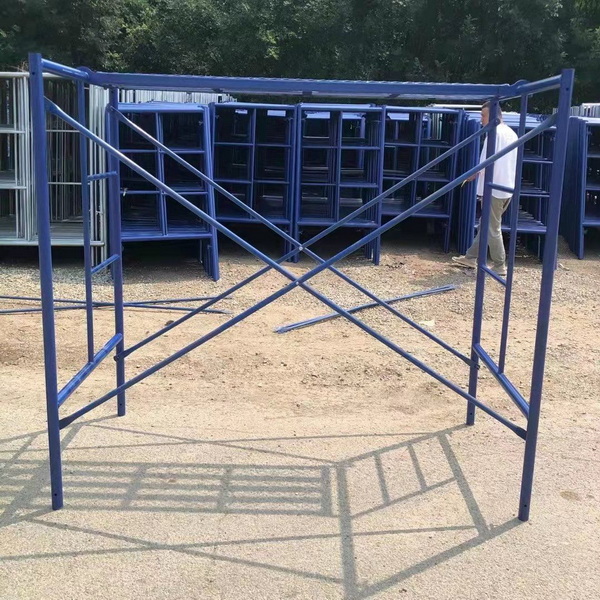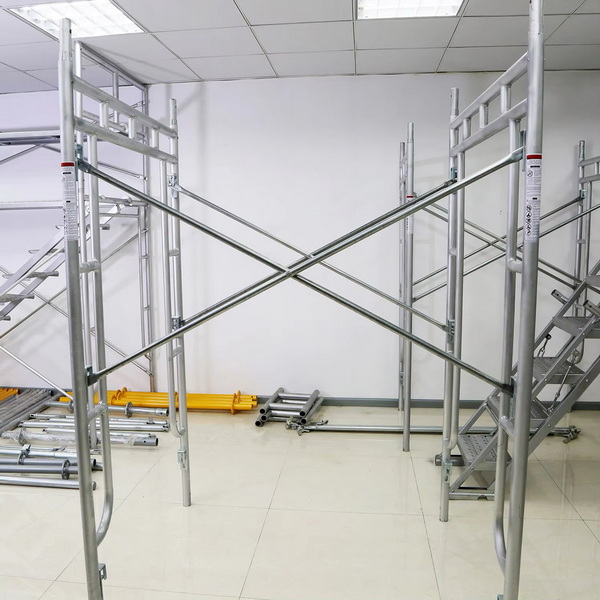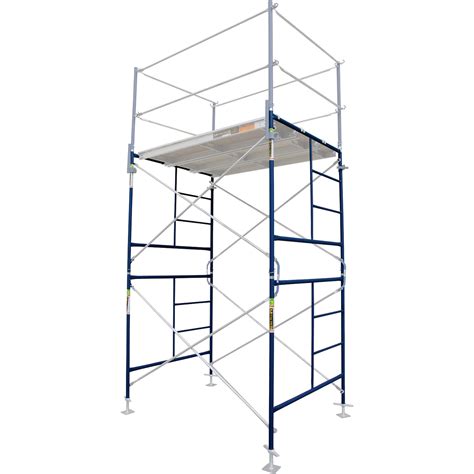Content Menu
● Understanding the H Frame Scaffolding System
>> What is an H Frame Scaffolding?
>> Components of an H Frame Scaffolding System
● Step-by-Step Guide to Assembling an H Frame Scaffolding System
>> 1. Select a Stable Foundation
>> 2. Lay Out All Components
>> 3. Position the H Frames
>> 4. Attach Cross Bracing
>> 5. Add Single Bracing
>> 6. Install Plan Bracing
>> 7. Secure Tie Bracing
>> 8. Attach the Working Platform
>> 9. Install Guardrails and Toeboards
>> 10. Final Safety Checks
● Additional Tips for Safe Assembly and Use
● Safety Precautions During Assembly and Use
● Conclusion
● FAQ
>> 1. What is the maximum height for H frame scaffolding?
>> 2. Can H frame scaffolding be moved while assembled?
>> 3. How often should scaffolding be inspected?
>> 4. What are common mistakes to avoid when assembling H frame scaffolding?
>> 5. Is training required to assemble H frame scaffolding?
H frame scaffolding is a widely used scaffolding system in the construction industry due to its simplicity, cost-effectiveness, and stability. Proper assembly of an H frame scaffolding system is crucial to ensure the safety of workers and the structural integrity of the scaffold. This comprehensive guide will walk you through the step-by-step process of assembling an H frame scaffolding system safely, highlight important safety precautions, and provide answers to frequently asked questions.

Understanding the H Frame Scaffolding System
What is an H Frame Scaffolding?
An H frame scaffolding system consists of vertical frames shaped like the letter "H," connected by horizontal and diagonal braces to form a stable structure. The system is designed to provide a secure elevated platform for construction, maintenance, and repair work such as bricklaying, painting, plastering, and more.
Components of an H Frame Scaffolding System
- H Frame: The backbone of the system, made of two vertical frames connected by horizontal cross braces, creating an "H" shape.
- Cross Bracing: Diagonal braces forming an 'X' pattern between vertical frames to prevent lateral movement.
- Single Bracing: Horizontal braces that add extra reinforcement between vertical frames.
- Plan Bracing: Horizontal braces parallel to the working platform, distributing weight evenly.
- Tie Bracing: Connects the scaffold to the building to prevent swaying or leaning.
- Working Platform: Planks or decks placed on horizontal bars for workers to stand on.
- Base Jack: Adjustable supports that ensure the scaffold is level on uneven ground.
Step-by-Step Guide to Assembling an H Frame Scaffolding System
1. Select a Stable Foundation
Begin by choosing a flat, stable surface free of debris or obstructions. If the ground is uneven, use adjustable base jacks to level the scaffold and ensure stability. The foundation is critical because any instability at the base can compromise the entire scaffold structure.
2. Lay Out All Components
Organize all scaffolding components including H frames, cross braces, single braces, plan braces, tie braces, base jacks, and platforms. Check each part for defects or damage before assembly. Damaged components should never be used as they can lead to structural failure.
3. Position the H Frames
Stand the vertical H frames upright at the desired location, aligned parallel to each other with the wider section facing outward. Ensure frames are spaced according to the manufacturer's specifications, typically around 6 to 10 feet apart depending on the scaffold height and load requirements.
4. Attach Cross Bracing
Connect cross braces diagonally between the vertical frames to form an 'X' shape. Secure the top end of the brace on one side and the bottom end on the opposite side. This step is critical for lateral stability and prevents the scaffold from swaying under load or wind pressure.
5. Add Single Bracing
Install single horizontal braces between the vertical frames to reinforce the structure and prevent sway. Single bracing is especially important on longer scaffold runs where extra lateral support is necessary.
6. Install Plan Bracing
Place plan braces parallel to the working platform, connecting the vertical frames. This distributes weight evenly and supports the working surface, ensuring that the platform remains stable under the weight of workers and materials.
7. Secure Tie Bracing
If the scaffold is adjacent to a building or structure, attach tie braces securely to anchor the scaffold and prevent movement. Tie bracing should be installed at regular intervals according to safety standards and manufacturer guidelines to maintain scaffold rigidity.
8. Attach the Working Platform
Lay the working platform or planks on the horizontal bars created by the cross braces. Ensure they are securely fastened and evenly distributed to support workers and materials safely. Platforms should be slip-resistant and free of defects.
9. Install Guardrails and Toeboards
For fall protection, install guardrails on all open sides of the scaffold platform, including midrails and top rails. Toeboards should also be installed to prevent tools or materials from falling off the platform, protecting workers below.
10. Final Safety Checks
- Confirm all locking pins and connections are secure.
- Check that guardrails and toeboards are installed on all open sides.
- Verify the scaffold is level and stable.
- Ensure all components are free from damage.
- Inspect the scaffold for any loose fittings or misaligned braces.

Additional Tips for Safe Assembly and Use
- Use Proper Tools: Utilize scaffold-specific tools such as spanners and hammers designed for scaffolding components to avoid damage and ensure secure fittings.
- Avoid Working Alone: Scaffold assembly should be done by at least two trained workers to manage heavy components and ensure safety.
- Weather Considerations: Avoid assembling or using scaffolding in high winds, heavy rain, or icy conditions as these can increase the risk of accidents.
- Load Management: Distribute materials evenly on the platform to prevent uneven loading, which can destabilize the scaffold.
- Training and Certification: Ensure all personnel involved in assembly and use are trained and certified according to local regulations and standards.
Safety Precautions During Assembly and Use
- Wear Personal Protective Equipment (PPE): Hard hats, safety harnesses, gloves, and non-slip footwear are essential.
- Follow Manufacturer Guidelines: Strictly adhere to the assembly instructions and weight limits.
- Avoid Overloading: Do not exceed the maximum load capacity including workers and materials.
- Conduct Regular Inspections: Inspect scaffolding components before and during use for signs of wear or damage.
- Use Guardrails and Toeboards: Prevent falls by installing these safety features on all platforms.
- Secure the Scaffold: Use tie bracing to anchor the scaffold to the building.
- Ensure Stable Base Support: Use base plates or adjustable jacks on uneven ground to prevent instability.
Conclusion
Assembling an H frame scaffolding system safely requires careful attention to detail, adherence to manufacturer guidelines, and strict safety protocols. By following the step-by-step assembly process, ensuring a stable foundation, securing all braces properly, and implementing safety measures such as guardrails and tie bracing, construction workers can create a reliable and safe working platform. Regular inspections and proper training further reduce the risk of accidents and improve efficiency on the job site. The H frame scaffolding system remains a cost-effective and versatile choice for many construction projects when assembled and used correctly.

FAQ
1. What is the maximum height for H frame scaffolding?
H frame scaffolding is generally suitable for heights up to about 30 feet (approximately 9 meters). For taller structures, additional safety measures or different scaffolding systems may be required.
2. Can H frame scaffolding be moved while assembled?
Yes, H frame scaffolding can be fitted with wheels for mobility. However, wheels must be locked securely before use to prevent movement and ensure safety.
3. How often should scaffolding be inspected?
Scaffolding should be inspected before each use and regularly throughout the project to identify any damage, wear, or loose components. Immediate replacement of defective parts is necessary to maintain safety.
4. What are common mistakes to avoid when assembling H frame scaffolding?
Common mistakes include ignoring manufacturer guidelines, poor inspection practices, incorrect assembly sequence, overloading the scaffold, inadequate base support, neglecting fall protection, and improper use of cross bracing.
5. Is training required to assemble H frame scaffolding?
Yes, workers should be trained in the correct assembly procedures, safety measures, and use of personal protective equipment to ensure safe and effective scaffold erection and dismantling.






















